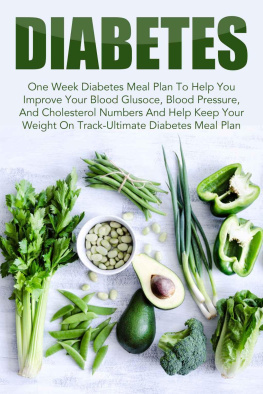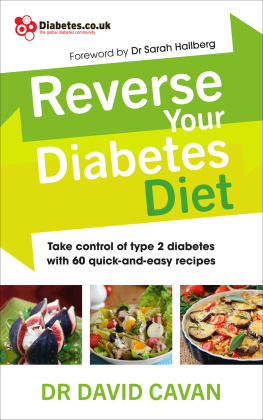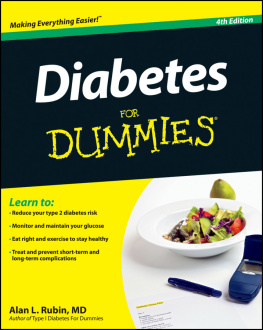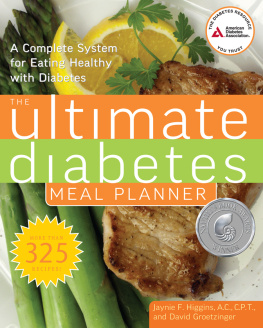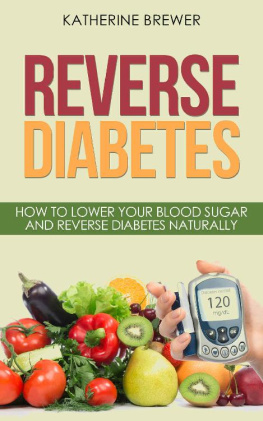Do you think that having diabetes means living a life of eating bland food? Well, let this book prove you wrong! Change your lifestyle for the better and learn how to treat your diabetes with the help of this book.
Always keep in mind that you can live a healthier and happier life with diabetes. Despite it being a disease, let it be your guide to taking better care of yourself. Respect your body by nourishing it with healthy and delicious meals, doing regular exercise, and getting regular check-ups. It all starts with proper planning.
This book contains a one week meal plan with over 40 delicious recipes to choose from, specially created to help diabetics improve blood glucose, blood pressure, and cholesterol numbers.
Learn to love your kitchen and prepare healthy breakfast meals, salads, and soups, as well as meat, vegetable, and seafood dishes. With this handy diabetic meal planner, you will never run out of ideas.
Chapter 1 - Diabetes: A General Overview
Nowadays, diabetes has become so common that a lot of people with it have learned how to adapt a healthier lifestyle. In fact, many of those who have been diagnosed with diabetes follow a healthier diet and daily regimen compared to those who do not have diabetes.
What is Diabetes?
Diabetes has something to do with the level of glucose in your blood. Glucose is a kind of sugar that is present in the body and is the source of energy for the organs and cells to continue functioning.
If you have diabetes, it means you exhibit any one of the following three diagnoses:
Casual blood glucose: at least 200 mg/dl any time during the day; experiencing frequent thirst and urination, fatigue, urinary tract infections, and fatigue. Normal casual blood glucose is between 70 to 138 mg/dl.
Fasting blood glucose: at least 126 mg/dl after not eating food for a minimum of 8 hours. The normal fasting glucose is less than 100 mg/dl.
Blood glucose of at least 200 mg/dl 120 minutes after ingesting 75 grams of glucose.
There are also three main types of diabetes: Type 1, Type 2, and Gestational.
Type 1 diabetes is also referred to as juvenile diabetes or insulin-dependent diabetes and it is usually caused by the body attacking its own pancreas. Children diagnosed as having Type 1 diabetes should take regular insulin shots.
Type 2 diabetes is also referred to as adult-onset diabetes and it starts when a person is around 40 years old. However, it has now become present among younger people because of the sedentary lifestyle led by many. This type of diabetes is caused by a resistance to insulin, therefore glucose stays in the blood instead of being distributed to the cells.
Gestational diabetes is similar to Type 2 but it is unique in women who are pregnant. This is caused by certain chemical changes in a pregnant womans blood which impedes the function of insulin.
How to Treat Diabetes
There are three important aspects in your lifestyle that you can change right now in order to treat your diabetes:
Medication: consult a reputable medical professional on diabetes to get prescription maintenance medication for your diabetes. However, it is imperative that you should not depend solely on medication alone. Medication can have an immensely negative effect on your kidneys and liver, especially if you continue to live a sedentary lifestyle and eat unhealthy food.
Exercise. There are plenty of exercises that you can engage in. Make sure to consult your doctor first though, for too strenuous exercises might trigger certain debilitating symptoms for diabetics.
Diet: avoid certain foods at all costs and stick to the ones recommended in this book. If you follow the meal plan given, you will be able to lower your average blood glucose by approximately 30 to 50 mg/dl. Pair this meal plan with exercise and proper medication and you will experience improvement in your health.
Chapter 2 - The One Week Diabetes Meal Plan
Controlling your caloric intake is very important, especially if you are diabetic. Everything should be in moderation, and whenever possible, eat your meals in small but frequent portions.
To help you get started on a healthier lifestyle, follow this 7 day diabetes meal plan. The recipes for the meals can be found in the next 6 chapters, along with additional recipes for meal plans that you might like to make on your own.
The great thing about these recipes is that you can whip them up for the entire family because they are really tasty.
Always make sure to have no more than 1 serving and to store the rest in a tightly lidded container in the refrigerator for future mealtimes.
Day 1:
Breakfast: Whole wheat waffles
Lunch: Fresh mushroom salad, Orange Roughy Bonne Femme
Dinner: Hearty Vegetable Soup, Zucchini Stuffed with Goat Cheese and Yellow Tomato Sauce
Day 2:
Breakfast: Warm blueberry oats
Lunch: Tahini Tomato and Cucumber Salad with Toasted Pine Nuts, Tilapia Franchaise
Dinner: Watermelon Gazpacho, Oriental Vegetable Stir Fry
Day 3:
Breakfast: Granola toast
Lunch: Teriyaki Salmon Salad, Broccoli with Creamy Lemon Sauce
Dinner: Corn and Sweet Potato Chowder, Roasted Leg of Lamb with Coriander
Day 4:
Breakfast: Almond blueberry pancakes
Lunch: Summer Tomato Salad, Pan Roasted Veal Chops with Corn and Gouda Ragout
Dinner: Pea Soup with Crab meat, Broiled Salmon with Herb Sauce and Cucumbers
Day 5:
Breakfast: Greek omelet
Lunch: Chickpea Salad, Low Carb Swiss Loaf
Dinner: Eggplant Lasagna, Zucchini Meat Loaf Italiano
Day 6:
Breakfast: Artichoke frittata
Lunch: Shrimp Salad
Dinner: Roasted Brussels Sprouts with Lemon and Capers, Pork Loin Glazed with Roasted Vegetable Salsa
Day 7:
Breakfast: Cheese broccoli pie
Lunch: Panzanella, Poached King Salmon with Steamed Asparagus and Tapenade Salsa
Dinner: Beer Braised Pork and Crisp Herb Cabbage with Apple and Tarragon Dipping Sauce
Important Guidelines
Before jumpstarting your diabetic meal plan, keep the following guidelines in mind:
Try not to use salt; use black pepper, herbs, and spices if you want more flavor instead.
Choose unsalted butter if the recipe requires butter. Never choose margarine because it contains trans fatty acids.
Choose yellow onions unless the recipe calls for another kind.
If you are still hungry even after a certain meal, load up on more leafy greens.
It is better to choose in-season and locally grown ingredients as substitutes than really sticking to the recipe.
Keep a food diary throughout the week to monitor the effects of your meals on your numbers.
Never eat outside of your scheduled meal plans. If you feel hungry in between meals, divide the serving in half and store the second half for you to eat two hours later. This will spread out your caloric intake throughout the day.

